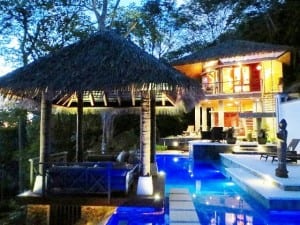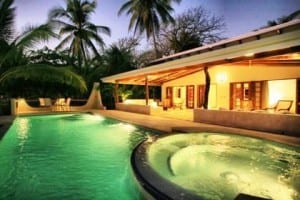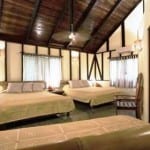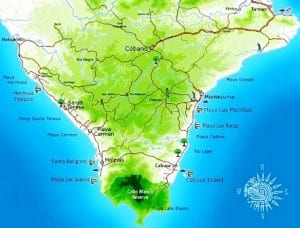Besides amazing looks, tropical architecture is all about working with the elements of nature to achieve thermal comfort in hot and humid climates. Tropical architecture, whether traditional, ultramodern or high-tech, uses passive design elements like sunshades, cavity walls, light shelves, overhangs, roof and wall insulation, and shading from large trees to block the intense tropical sun, according to Tropical Architecture articles. Tropical houses, especially those with Asian design, often have big roof overhangs to protect interior spaces from the tropical sun’s brightness.
Costa Rica is a tropical country with many microclimates and elements to take into account for architectural design. Costa Rica’s tropical architecture tends to follow three styles: Asian/Balinese, Mediterranean, or Spanish colonial. Environmentally correct and sustainable designs are most in fashion nowadays. According to the firm Costa Rican Architects, tropical design creates a harmonious relationship between nature and humans.
Costa Rican Architects say the main feature of tropical design is including the outside world to create an ambiance of openness and naturalness. Architects are in constant pursuit of breezes, cross-ventilation and shade for cooling effects, and sunlight for warmth, energy and light; they look for quick and efficient rainfall management, and using topography and vegetation for a vibrant aesthetic effect, privacy and acoustic insulation. Good environmental design incorporates local and natural materials, recycling, water management, and energy efficiency.
Hotel Tropico Latino, on Costa Rica’s Santa Teresa Beach on the Nicoya Peninsula, is a good example of tropical architecture. The hotel uses tropical woods, stone, ceramic tile and polished white concrete in both traditional tropical beach-style architecture and ultramodern minimalist designs. Room designs work in harmony with the natural environment, allowing for cross-ventilation with cooling sea breezes, using natural shade from palms and other large trees, and exuberant tropical plants for aesthetic beauty and privacy.
Once a small fishing village, the jungle at Santa Teresa sweeps down low mountains to the Pacific Ocean, hugging the shore and creating one of the most beautiful beaches of Costa Rica. Imagine your own private tropical residence right on the beach, relaxing in a private pool and Jacuzzi while watching dazzling sunsets over the Pacific Ocean, then dining al fresco on your private terrace. That’s the Beachfront Suite at Hotel Tropico Latino. One of the hotel’s newest buildings, the Beachfront Suite is constructed in a “minimalist design” with plenty of built-in furniture in polished white concrete, natural wood posts, wood beams, ceramic tile floors, and large doors that let in fresh sea breezes.
Just upstairs above the Beachfront Suite are the second-story Superior Beachfront Rooms that overlook the sea and beach a few feet away. These newest rooms are decorated in sparkling white with bright tropical accent colors in a modern clean design.
Hotel Tropico Latino definitely took into account the outside environment when they created their Beachfront Rooms. You can step right out into the sand from a large wooden deck, and private bathrooms are open-air with a garden, some with a bathtub.
All other accommodations -- Beachfront Bungalows, Beachfront Studio, Garden View Bungalows, Garden View Rooms, Standard Rooms, and even a Two-Bedroom House – all feature tropical architecture with natural stone, wood floors and ceilings, outdoor decks or porches, cool white walls, wood detailing, large windows to let in the light and outdoors, all amid lush tropical gardens.
Hotel Tropico Latino fronts Santa Teresa Beach on four acres of tranquil, abundant gardens – a heavenly Costa Rica vacation destination. Hotel Tropico Latino features a full-service beachfront Spa, a beachfront yoga platform with daily classes and activities, surfing and surf instruction in front of the hotel, and regular yoga and surf retreats. The open-air beachfront Shambala Restaurant, run by award-winning Chef Randy Siles, is nationally-recognized for its delicious and creative international cuisine. It’s easy to relax there with a beachside pool and plenty of hammocks strung under a grove of coconut and almond trees; sunsets are breathtaking.
To get to Playa Santa Teresa, drive to the port of Puntarenas on Costa Rica’s Central Pacific Coast and take the ferry (1-1/2 hours) to Paquera; drive another 75-90 minutes, going past Tambor and Cobano to the crossroads for Mal Pais and Santa Teresa; turn right toward Santa Teresa. Direct bus connections travel regularly between San José and Santa Teresa using the ferry. Many visitors take a domestic flight to Tambor on either Nature Air or Sansa Airlines; Santa Teresa is approximately a 50-minute drive from the Tambor airport. You can also take a taxi boat from the Central Pacific beach town of Jaco that departs daily at 10:45 am and arrives in one hour to Montezuma at the tip of the Nicoya Peninsula; from there it is an hour drive to Santa Teresa.
By Shannon Farley






Comments